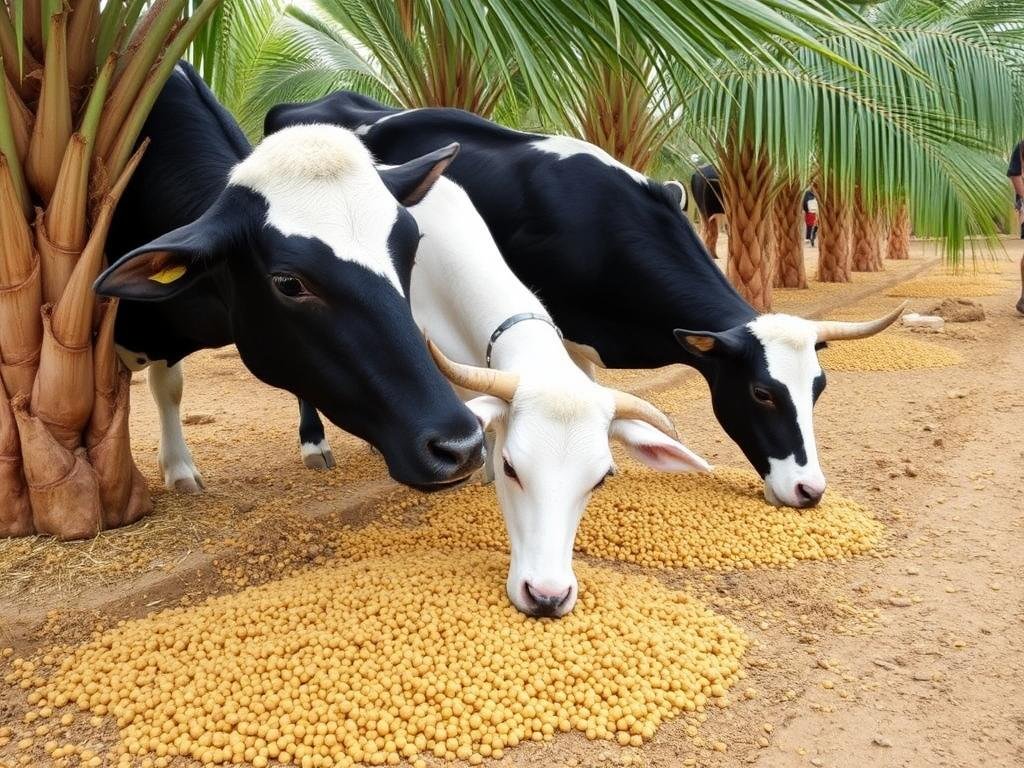Palmiye Çekirdeği Çıkarıcı (PKE): Hayvan Yemi İçin 2024'ün Nihai Rehberi
Maliyet etkin ve sürdürülebilir hayvan yemi bileşenleri arayışında, değerli bir yan ürün önemli bir ivme kazandı: Palm Çekirdeği Ekspeller (PKE). Peki PKE tam olarak nedir ve yem oranlarında nasıl kullanılır? Bu nihai 2024 rehberi, hayvan yemlerindeki temel kullanımlarını inceleyerek besin profilini, faydalarını ve çeşitli çiftlik hayvanları için uygulamalarını açıklıyor.
İçindekiler
- 1. Palm Kernel Expeller (PKE) nedir?
- 2. PKE'nin Beslenme Profili
- 3. Ruminant Yemlerinde PKE'nin Temel Kullanımları
- 4. PKE Geviş Getirmeyen Hayvanlarda da Kullanılabilir mi?
- 5. PKE'nin Avantajları ve Dezavantajları
- 6. PKE Sürdürülebilirliği ve Kaynak Temini
- 7. Yüksek Kaliteli Palmiye Ürünlerinin Kaynağı
- 8. Son Düşünceler
Palm Kernel Expeller (PKE) nedir?
PKE, palmiye yağı endüstrisinin önemli bir yan ürünüdür. Süreç, Yağ Palmiyesi Meyve Demeti, etinin preslenerek üretildiği Ham Palm YağıBundan sonra, değerli meyveyi ortaya çıkarmak için palmiye cevizi kırılır. Palmiye Çekirdeği.
Çekirdek ezilmeden önce sert dış tabakasından ayrılır, Palmiye Çekirdeği Kabuğu, biyoyakıt için sıklıkla kullanılan bir diğer yararlı yan üründür. Çekirdek daha sonra bir presleme presinde ezilerek çıkarılır Hurma Çekirdeği Yağı.
Geride kalan katı, protein açısından zengin lifli malzeme PKE'dir. Yüksek lif ve orta düzeyde protein içeriğiyle bilinir ve bu da onu hayvan beslenmesi için değerli, ancak karmaşık bir bileşen yapar. Bulunabilirliği ve uygun fiyatlı olması onu birçok yem formülasyonunda temel bir madde haline getirmiştir.

PKE'nin Beslenme Profili
PKE'nin besin değeri, yağ çıkarma yöntemine ve çekirdeklerin kalitesine göre değişebilir. Ancak, genellikle beslenme uzmanlarının üzerinde çalıştığı tutarlı bir profile sahiptir.
Protein ve Enerji İçeriği
PKE tipik olarak 14-18% ham protein içerir. Yararlı olsa da, lizin ve metionin gibi temel amino asitler açısından soya fasulyesi unu kadar zengin değildir. Enerji içeriği orta düzeydedir, esas olarak kalıntı yağdan (5-12%) ve sindirilebilir liften gelir.
Yüksek Lif: Çift Taraflı Bir Kılıç
PKE'nin tanımlayıcı bir özelliği yüksek lif içeriğidir (15-20% ham lif). Bu, sağlıklı rumen fonksiyonunu desteklediği için sığırlar gibi geviş getiren hayvanlar için bir nimettir. Ancak kümes hayvanları ve domuzlar gibi tek mideli hayvanlar için bu yüksek lif besin emilimini sınırlayabilir.
Temel Mineraller ve Vitaminler
PKE, fosfor, magnezyum ve demir gibi minerallerin iyi bir kaynağıdır. Ancak yüksek bakır içeriği koyunlar için toksik olabilir, formüle ederken önemli bir husustur koyunlara özgü sürüler için yem.
Ruminant Yemlerinde PKE'nin Temel Kullanımları
PKE'nin gerçekten parladığı yer geviş getirenlerdir. Benzersiz sindirim sistemleri, yüksek lif içeriğini etkili bir şekilde parçalayabilir ve besinlerini açığa çıkarabilir.
Süt Sığırları: Süt Bileşenlerini Artırmak
Süt oranlarında, PKE hem protein hem de lif kaynağı olarak hizmet eder ve genellikle toplam diyetin -30%'sine dahil edilir. Lif, metabolik bozuklukları önlemek için çok önemli olan stabil bir rumen pH'ının korunmasına yardımcı olur. Süt Bilimi Dergisi Bu tür lif kaynaklarının süt yağını nasıl etkilediğini sık sık vurgular.
Sığır Eti: Maliyet Etkin Bir Besi Çözümü
Et sığırları için PKE, bitirme oranlarına hacim, protein ve enerji eklemenin uygun maliyetli bir yoludur. Doğru formüle edildiğinde, daha pahalı tahılların veya protein kaynaklarının yerini alabilir ve kilo alımından ödün vermeden üretim maliyetlerini düşürebilir.
PKE Geviş Getirmeyen Hayvanlarda da Kullanılabilir mi?
PKE'nin geviş getirmeyen diyetlerde kullanımı sınırlıdır ancak mümkündür. Birincil zorluk, yüksek lif nedeniyle zayıf sindirilebilirliğidir.
Kümes Hayvanları (Etlik ve Yumurta Tavukları)
Tavuklar için, yüksek PKE seviyeleri kumlu dokusu nedeniyle büyümeyi baskılayabilir. Ancak, düşük katılım oranlarında (10%'nin altında), dolgu maddesi olarak kullanılabilir. Etkinlik, lifleri parçalamaya yardımcı olan yem enzimleriyle artırılabilir.
Domuz Yemi Formülasyonları
Kümes hayvanlarına benzer şekilde, domuzlar da PKE'deki yüksek lifi iyi idare edemezler. Kullanımı genellikle gebe dişi domuzlarla sınırlıdır veya yetiştirici-bitirici diyetlerinde minimum seviyelerdedir. FAO'nun yem kaynakları veritabanı Daha fazla bilgi için mükemmel bir kaynaktır.
PKE'nin Avantajları ve Dezavantajları
Herhangi bir yem bileşeni gibi PKE'nin de üreticilerin değerlendirmesi gereken avantajları ve dezavantajları vardır.
- Faydalar: Uygun maliyetli, kolay bulunabilen ve ruminant sağlığı için mükemmel bir lif kaynağıdır.
- Dezavantajları: Değişken kalite, düşük lezzetlilik, yüksek bakır içeriği (koyunlar için toksik) ve monogastriklerde düşük sindirilebilirlik.
PKE Sürdürülebilirlik ve Kaynak
Sürdürülebilirlik, palmiyeden elde edilen herhangi bir ürün için temel bir endişe kaynağıdır. Kaynak sağlamak çok önemlidir. Palm Çekirdeği Ekspeller (PKE) sertifikalı tedarikçilerden.
Gibi kuruluşlar Sürdürülebilir Palmiye Yağı Yuvarlak Masa Toplantısı (RSPO) Çevreye zarar vermeden üretilen palmiye ürünlerini sertifikalandırın. RSPO sertifikalı PKE'yi seçmek, sorumlu çiftçiliği ve sürdürülebilir bir tedarik zincirini destekler.

Yüksek Kaliteli Palmiye Ürünlerinin Kaynağı
Makmur Amanah Sejahtera, Palmiye Çekirdeği Ekspelleri, Palmiye Çekirdeği Kabuğu, Ham Palmiye Yağı, Palmiye Çekirdeği Yağı ve daha fazlası gibi yüksek kaliteli palmiye ürünleri sağlar. Lütfen WhatsApp +6282140002198 numaralı telefondan bize ulaşın veya admin@makmuramanah.co.id adresinden bize e-posta gönderin.
Son Düşünceler
Özetle, PKE çok yönlü ve ekonomik bir yem bileşenidir, lifinin bir avantaj olduğu sığır gibi geviş getiren hayvanlar için en uygunudur. Kümes hayvanı, domuz ve koyun yemlerinde kullanımı mümkün olsa da dikkatli bir formülasyon gerektirir.
PKE'nin benzersiz özelliklerini anlayarak, hayvan beslenme uzmanları maliyetleri düşürmek ve hayvan sağlığını desteklemek için onu stratejik olarak oranlara dahil edebilirler. Sonuç olarak, kalite ve sürdürülebilir kaynak, başarılı kullanımı için en önemli unsurdur.
